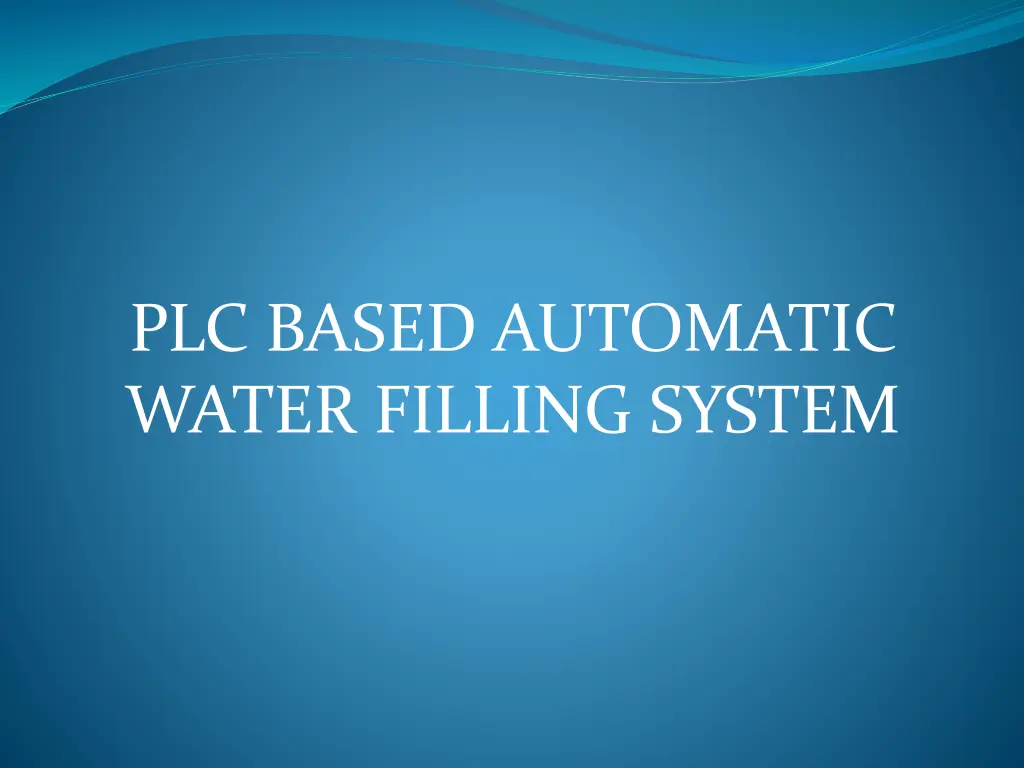
Automation Technology: PLC Based Water Filling System Overview
Dive into the world of automation with this detailed exploration of PLC-based automatic water filling systems, including the importance of automation, types of PLCs, and the role of Programmable Logic Controllers in industrial processes. Discover the benefits, applications, and future scope of automation in various industries.
Download Presentation

Please find below an Image/Link to download the presentation.
The content on the website is provided AS IS for your information and personal use only. It may not be sold, licensed, or shared on other websites without obtaining consent from the author. If you encounter any issues during the download, it is possible that the publisher has removed the file from their server.
You are allowed to download the files provided on this website for personal or commercial use, subject to the condition that they are used lawfully. All files are the property of their respective owners.
The content on the website is provided AS IS for your information and personal use only. It may not be sold, licensed, or shared on other websites without obtaining consent from the author.
E N D
Presentation Transcript
PLC BASED AUTOMATIC WATER FILLING SYSTEM
CONTENTS OBJESTIVE INTRODUCTION OF AUTOMATION TYPES OF AUTOMATION IMPORTANCE OF AUTOMATION WHAT IS PLC? WHY PLC? TYPES ,OPERATIONS AND APPLICATIONS BLOCK DIAGRAM ,WIRING DIAGRAM AND WORKING OF AUTOMATIC WATER FILLING SYSTEM APPLICATIONS ADVANTAGES FUTURE SCOPE CONCLUSION
INTAUTOMATION RODUCTION The use of machines and technology to make processes run on their own without manpower. The technique of making an apparatus, a system operate automatically.
ION TYPES OF AUTOMATION BUILDING AUTOMATION : Eg : Lifts, Smoke detectors OFFICE AUTOMATION Eg : CCTV Camera LIGHT AUTOMATION Eg :Street solar lightening INDUSTRIAL AUTOMATION Eg :Automated bottle filling system,steel factories,etc
IMPORTANCE OF AUTOMATION Increases the machine efficiency. Flexibility and convertibility in manufacturing process Increase production rates
WHAT IS PLC? PLC means Programmable Logic Controller. These systems perform many functions, providing a variety of analog and digital input and output interfaces; signal processing; data conversion; and various communication protocols.
PLC LANGUAGES Ladder diagram Function Block diagram Sequential Function Chart Structured Text Instruction List
WHY PLC PLC play an important role in automaton, this device can manage and control entire industry to produce better and quick output. A PLC is a digital computer used for automation of industrial processes, like controlling machinery or factory Reduces human effort. Get maximum effeciency.
TYPES OF PLC Allen Bradley PLCs (AB) ABB PLCs (Asea Brown Boveri) Siemens PLCs Omron PLCs Mitsubishi PLCs Hitachi PLCs Delta PLCs General Electric (GE) PLCs Honeywell PLCs Modicon PLCs Schneider Electric PLCs Bosch PLCs
Our plc model is DELTA DVP-60ES2. It consists of 36 inputs and 24 outputs.All inputs and outputs are in digital (binary format)type. It represent to X0,X1,X2,X3,X4,X5,X6,X7,X8,X9,X10,X11,X12,X13,X14,X15,X16,X 17,X20,X21,X22,X23,X24,X25, X26,X27,X30,X31,X32,X33,X34,X35,X36,X37,X40,X41,X42,X43 are inputs. And out puts are Y0,Y1,Y2,Y3,Y4,Y5,Y6,Y7,Y10,Y11,Y12,Y13,Y14,Y15,Y16,Y17,Y20 ,Y21,Y22,Y23,Y24,Y25,Y26,Y27. C0,C1,C2,C3,C4,C5 are common pins. COM1,COM2,COM3 are communication ports. RUN AND STOP BUTTON to run and stop the PLC.
OPERATION OF PLC The operation of the PLC system is simple. It consists of three processes: 1. Scans or reads, from the input devices. 2. Executes or solves the program logic. 3. Writes to the output devices.
APPLICATIONS OF PLC Used for packaging machine. Spinning machine. Winding machine (tension control). Molding injection machine. .
AUTOMATIC WATER FILLING SYSTEM Our project is based upon closed loop control system. A Closed-loop Control System, also known as a feedback control system is a control system which uses the concept of an open loop system as its forward path but has one or more feedback loops (hence its name) or paths between its output and its input. The reference to feedback , simply means that some portion of the output is returned back to the input to form part of the systems excitation.
Block diagram of Closed Loop control system
AUTOMATIC WATER FILLING SYSTEM BLOCK DIAGRAM
COMPONENTS USED: DC SERVO MOTORS PHOTO ELECTRIC SENSORS CONVEYOR BELT MOTORS ELETRO MAGNETIC RELAY AC & DC TERMINAL BLOCKS MCB & SMPS
WORKING When the start button is pushed, the motor starts hence the conveyer belt starts moving. When the bottle is under the solenoid valve, the bottle is sensed and the motor stops hence the conveyer belt stops. Then the solenoid valve operates and the bottle starts filling the water. When the bottle completes filling process, the solenoid valve is closed and the motor starts, the conveyer belt starts moving and carries the bottle away from the solenoid valve. If another bottle is sensed then the above process will be repeated. When stop button is pressed or activated then the entire process will be stopped.
INPUTS X0 ------WATER LEVEL SENSOR X1--------PUSH BUTTON X2-----CONVEYOR BELT SENSOR OUTPUTS Y0 ------RESERVOIR MOTOR Y1--------WATER TANK MOTOR Y2 & Y3 -----------CONVEYOR BELT MOTOR M0,M1,M2-----------MEMORY BITS T0,T1-------------TIMERS
MERITS Less man power required. Less time taken. Fast and accurate. Less wiring. Easier and faster to make changes.
APPLICATIONS Stand alone water bottle booth system. Ink filling industry. Soft-drink & water filling industries. Beer and wine industries. Olive oil industries.
CONCLUSION We have achieved our objective that is bottle filling process using PLC. This was successfully implemented. We consider this project as a journey where we acquired knowledge on automation industry. Also gained some insights into the subject which we have shared in this report
PRESENTED BY K.Apparao B.Chandrasekhar CH.Bhagya Lakshmi N.Livingstan S.Naga Satya Prasad UNDER THE GUIDENCE OF M.KARTHIK Sir
